Definition of Erythrocytes, Function, Characteristics, Structure, Process & Value
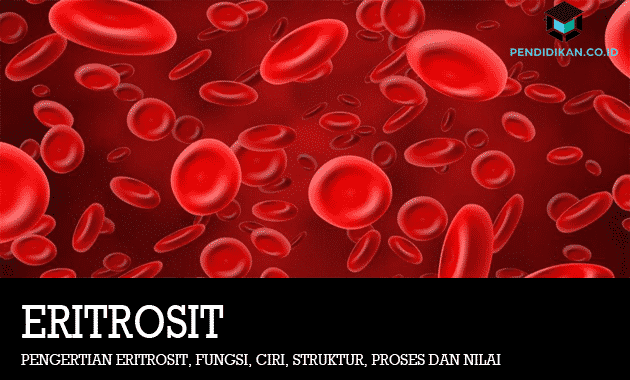
Definition of Erythrocytes
Red blood cells are the simplest cells in the body. In medical terms, red blood cells are known as erythrocytes. Erythrocyte is a term that comes from the Greek, namely from the word erythos which means red and also kytos which means blood sheath.
This erythrocyte is a part of the blood cells with the largest number in the body whose production differs between the fetal period and the postnatal period. In the first few weeks of embryonic life, primitive nucleated red blood cells are produced in the yolk sac. At the time of entering the middle of the trimester of gestation, then the production of erythrocytes is taken over by the liver (which is the main organ of erythrocyte production), spleen and lymph nodes. Then, approximately during the last month of pregnancy and after birth, these erythrocytes are only produced in the bone marrow.
Bone marrow of all bones will then produce erythrocytes until a person is 5 years old, with the exception of the proximal humerus (hand) and tibia (shin bone). The proximal humerus and tibia will only produce a few erythrocytes even after that they do not produce anymore when they reach the age of approximately 20 years. After that age, these erythrocytes will be produced in the membranous bone marrow, such as the vertebrae (spine), sternum (breastbone), costae (ribs) and the ilium. However, the number of erythrocytes produced by this membranous bone marrow will also decrease and decrease as a person ages.
Erythrocyte Function
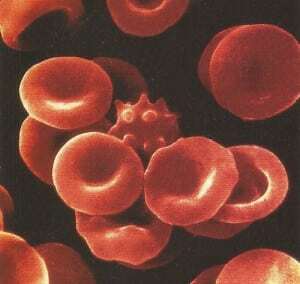
Red blood cells have an important role in the body, including:
The main function of these erythrocytes is to circulate oxygen-rich blood (O2) from the lungs to all body tissues. In carrying out these functions, erythrocytes are assisted by the presence of hemoglobin (Hb). Hb is an erythrocyte substance consisting of heme and globin chains. This heme chain is an iron protoporphyrin compound that forms a pigment part or also a protein-free part in Hb and has a role in transporting O2.
These erythrocytes have a role as an acid-base buffer that is good for the whole blood.
Erythrocytes contain the enzyme carbonic anhydrase, which is an enzyme that has the function of increasing the rate at which it is transported catalyzes a reversible reaction between carbon dioxide (CO2) and water (H2O) to form or can form carbonic acid (H2CO3). fold.
This Hb is as an erythrocyte substance that has a role in fending off pathogens or bacteria by going through a lysis process by releasing free radicals that can or can destroy pathogenic cell membranes and kill bacteria bacteria. Therefore, it is said that these erythrocytes have a role in maintaining the immune system (antibodies).
These erythrocytes have a function in the dilation of blood vessels. This mechanism may or may occur due to the presence of S-Nitthrosothiol compounds which are released when Hb is deoxygenated.
Features of Erythrocytes
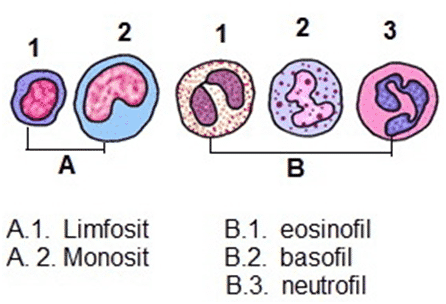
The characteristics of these erythrocytes, including the following:
- Has a round shape and the center is concave or bi-concave
- Does not have a cell nucleus
- It has a red color due to its high hemoglobin content
- It has a long life of approximately 120 days when it is formed
- Has a number of 4 to 5 million blood cells
- Has a diameter of about 7 to 8 um with a thickness that reaches 1-2 um
- Has thick elastic properties
Erythrocyte Structure
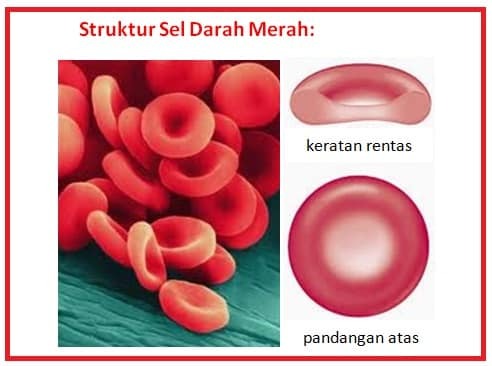
Red blood cells are cells that have a simpler structure when compared to other cells. These cells do not have organelles such as mitochondria, lysosomes, golgi apparatus and nucleus. However, even so the red blood cells are not inert. The presence of the Hb substance in the erythrocytes then gives the blood a red color.
The structure of this normal erythrocyte is that it does not have a nucleus and also has a biconcave plate shape with a diameter of approximately 7-8 micrometers and with a thickness of 2.5 micrometers at the thickest and 1 micrometer or less in the thickest part the middle. The shape of the red blood cell may change as the cell passes through the capillaries, but this change in shape will not cause the cell to rupture. This is because under normal circumstances, these red blood cells have an advantage cell membrane to be able to accommodate a substance in it so that it will not stretch the membrane great.
The average volume of red blood cells in each individual is 90-95 cubic micrometers, while for The number of red blood cells is very dependent on gender and the terrain where you live someone. In normal men, the average number of red blood cells per cubic millimeter is 5,200,000 (±300,000) and in normal women 4,700,000 (±300,000). People who live in the highlands have a greater number of red blood cells than people who live in the lowlands.
Erythrocyte Formation Process
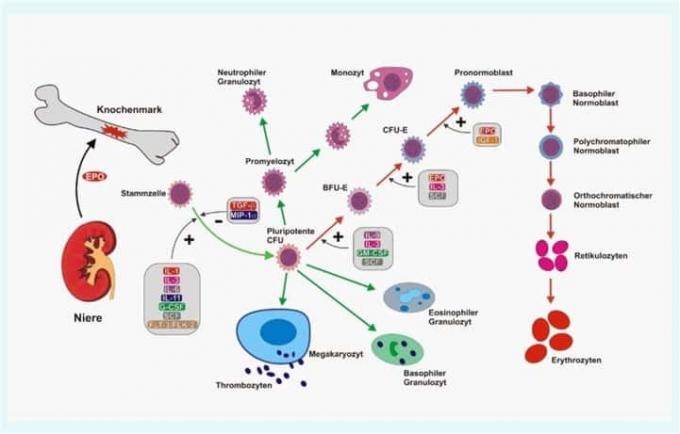
The process of formation of erythrocytes is called erythropoiesis. The formation of erythrocytes is then regulated by a glycoprotein hormone called erythropoietin. The first cell to be recognized as a series of erythrocyte formation is the proerythroblast, which is formed from CFU-E stem cells. Once the proerythroblast cells are formed, they will then divide several times. The new cells from the first generation of division are called basophil erythroblasts because they can or can be painted with alkaline colors. These cells contain very little hemoglobin.
In the next stage of cleavage, the number of HB formed is more than before. Cells formed at this stage are called polychromatophilic erythroblasts. Then in the next stage, the amount of Hb formed will be more and more and has given a red color in the cells. These cells are known as orthochromatic erythroblasts. In the next generation, these cells are filled with Hb up to a concentration of 34%, the nucleus it condenses into small, and also for the rest is finally absorbed and then pushed out from the cell. At the same time, the endoplasmic reticulum is reabsorbed. Then the cells in the next stage are called reticulocytes, because they still contain small amounts of basophilic material consisting of remnants of mitochondria, the Golgi apparatus, and also a few cytoplasmic organelles other.
During the reticulocyte stage, these cells will then travel from the bone marrow to enter the capillary by means of diapedesis (ie squeezed by means of membrane pores). capillary). The basophilic material remaining in the reticulocytes normally disappears within 1 to 2 days, and after that they become mature erythrocytes. Due to the short life span of reticulocytes, its concentration among all blood cells is normally slightly less than 1 percent.
If the erythrocytes have been or are already in circulation, then under normal circumstances the lifespan of the red blood cells is approximately only 120 days. Old or aged red blood cells become more fragile and may or may burst on their way through narrow blood vessels. Some of these erythrocytes will rupture in the spleen due to being squeezed when passing through the red pulp of the spleen and some will be disassembled in the liver. Hb released from erythrocytes will then be phagocytosed and digested by macrophage cells, especially those in the spleen, liver and bone marrow. After that in the liver, the hemoglobin is converted into bile dye (bilirubin) which will be accommodated in the gallbladder. Bilirubin has the function of giving color to the stool. The iron contained in hemoglobin is transported after it is released and transported into the bone marrow to be used in the body in the formation of new red blood cells or is also stored in the liver and other tissues in the form of ferritin.
In the stages of erythrocyte formation, the hormone erythropoietin, O2 levels in the air, cobalt (Co), protein, iron (Fe), copper (Cu), and vitamin B12 are important to note because they are factors that certainly affect the process that.
Erythrocyte Value

Erythrocyte Normal Value
This erythrocyte test can or can be done to determine an erythrocyte level. This test is done to evaluate the number of red blood cells to help diagnose and also monitor conditions that affect red blood cells.
Normal erythrocyte values can or can be different in each person and are influenced by age, sex, and health conditions. Below are normal erythrocyte values:
- Children: 4.0 to 5.5 million/microliter
- Adult male: 4.5 to 5.9 million/microliter
- Adult women: 4.1 to 5.1 million/microliter
- 1st trimester pregnant women 3.42 to 4.55 million/microliter
- 2nd trimester pregnant women 2.81 to 4.49 million/microliter
- 3rd trimester pregnant women 2.72 to 4.43 million/microliter
each laboratory can or can have a range of normal values of erythrocytes that also vary, but generally the rarity will not be much different.
Erythrocyte Abnormal Value
If a person's erythrocyte levels are too high or too low, it indicates a red blood cell problem. When the erythrocyte value is high, the condition is known as polycythemia. Meanwhile, if the erythrocyte value is low, it is called anemia.
Erythrocyte value is too high
Erythrocyte values that are too high are caused by an increase in the number of erythrocytes or red blood cells. This condition is a rare condition. The most common cause of high erythrocytes or polycythemia is due to conditions such as the following:
- Lung disease
- Congenital heart disease
- Polycythemia vera
- Kidney tumor
Erythrocyte value is too low
The low erythrocyte value is generally indicated by reference to the red blood cell value and the low hematocrit. This condition is known as anemia. Conditions that can or can cause low erythrocyte values include:
- Losing a lot of blood
- Certain nutritional deficiencies
- Excessive destruction of red blood cells
- Thalassemia
- Spinal cord disorders
- Chronic disease or inflammation
Thus an explanation of the Definition of Erythrocytes, Functions, Characteristics, Structure, Processes and Values, hopefully what is described can be useful for you. thank you
See AlsoUnderstanding Mind Maps, Methods, Solutions, How to Create and Its Benefits
See AlsoDefinition of Synchronic and Diachronic
See AlsoUnderstanding Imperative Sentences, Functions, Characteristics, Kinds and Examples
